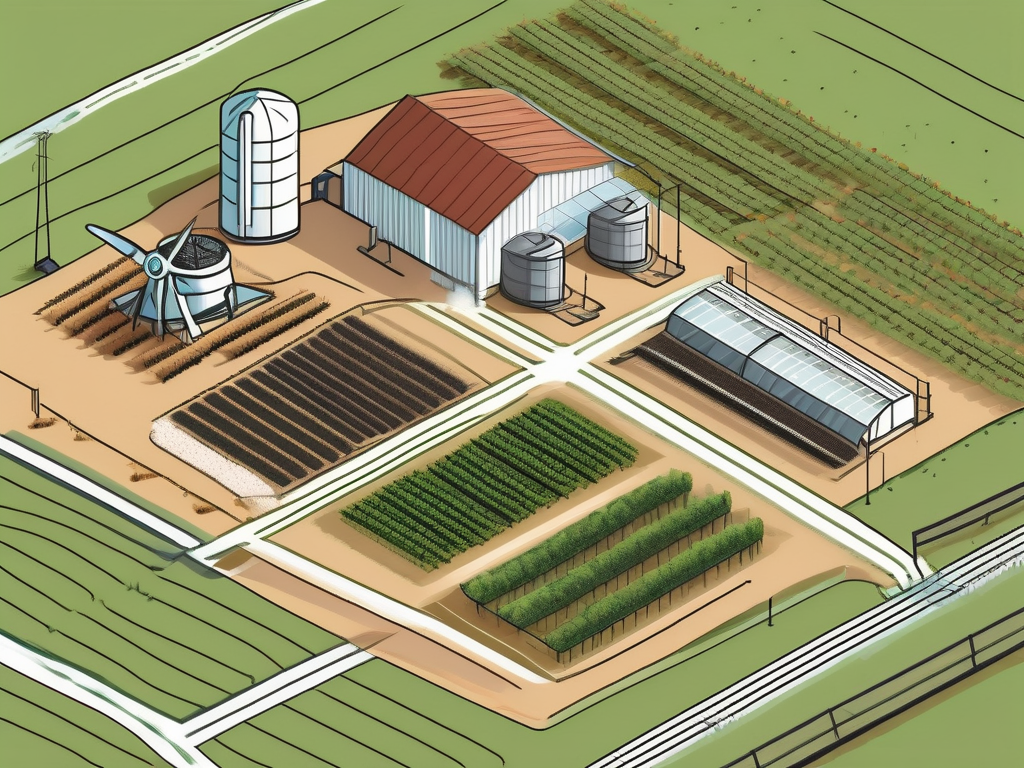
Busting Agricultural Capital Expenditure Myths
In the world of agriculture, capital expenditures play a vital role in ensuring sustainable growth and productivity. However, there are many misconceptions surrounding this topic that need to be addressed. In this article, we will debunk common myths about capital expenditures in agriculture, shed light on their importance and impact on the agricultural sector, and provide insights on making informed decisions regarding these expenditures.
Understanding Capital Expenditures in Agriculture
Before we dive into debunking myths, let's establish a clear understanding of what capital expenditures are and why they hold significant importance in agriculture.
Definition and Importance of Capital Expenditures
Capital expenditures refer to the investments made by agricultural businesses in long-term assets that are essential for their operations. These assets can include machinery, equipment, land, infrastructure, and technology.
Capital expenditures are crucial for the growth and development of agricultural operations. They enable farmers to enhance their efficiency, productivity, and overall profitability. By investing in high-quality equipment and technology, agricultural businesses can automate processes, improve yields, and reduce labor-intensive tasks.
How Capital Expenditures Impact the Agricultural Sector
The impact of capital expenditures in agriculture is far-reaching and can be witnessed across the entire agricultural sector. These investments not only benefit individual farmers and agricultural businesses but also contribute to the overall economic growth and food security of a nation.
Increased Productivity: Capital expenditures allow farmers to adopt advanced farming techniques and technologies. By leveraging modern machinery and equipment, farmers can increase their productivity, reduce post-harvest losses, and optimize resource utilization.
Job Creation: Capital investments in agriculture lead to the creation of employment opportunities. As farmers adopt new technologies and expand their operations, they often require skilled workers to operate and maintain the machinery and equipment.
Sustainable Agriculture: Capital expenditures pave the way for sustainable farming practices. Investments in eco-friendly technologies, such as precision agriculture, water management systems, and renewable energy sources, promote resource conservation and reduce the environmental impact of agricultural activities.
Moreover, capital expenditures in agriculture also play a vital role in fostering innovation and research. Agricultural businesses invest in research and development to improve crop varieties, develop new farming techniques, and find sustainable solutions to challenges faced by the industry.
Additionally, capital expenditures contribute to the overall infrastructure development in rural areas. As agricultural businesses invest in land and infrastructure, they not only improve their own operations but also enhance the overall connectivity and accessibility of rural areas.
Furthermore, capital expenditures in agriculture have a multiplier effect on the economy. When farmers invest in new equipment or technology, they often purchase these goods from manufacturers, which stimulates economic activity and supports other industries.
In conclusion, capital expenditures in agriculture are essential for the growth, productivity, and sustainability of the sector. These investments not only benefit individual farmers but also contribute to job creation, innovation, infrastructure development, and economic growth. By understanding the importance of capital expenditures, we can appreciate the significant role they play in shaping the future of agriculture.
Common Myths Surrounding Agricultural Capital Expenditures
Now that we have explored the importance of capital expenditures in agriculture, let's address some common myths that often overshadow their significance:
Myth 1: Capital Expenditures are Unnecessary in Agriculture
Contrary to this belief, capital expenditures are crucial for the long-term success and sustainability of agricultural operations. While it's true that initial investment costs may seem intimidating, the benefits reaped in terms of increased productivity and efficiency far outweigh the expenses in the long run.
Agricultural businesses must allocate funds for capital expenditures to ensure they remain competitive in an evolving industry. By continuously upgrading their assets, farmers can adopt innovative technologies and stay ahead of the curve.
For example, investing in state-of-the-art irrigation systems can help optimize water usage, reducing waste and ensuring crops receive the right amount of moisture. This not only improves crop quality but also minimizes the environmental impact of farming practices.
Myth 2: Small Farms Don't Require Significant Capital Expenditures
Size should not be a determining factor when it comes to capital expenditures in agriculture. Regardless of farm size, implementing efficient processes and utilizing modern equipment can help small farms boost their productivity and profitability.
Moreover, the availability of various financing options, such as loans and lease programs, helps smaller farms access the necessary capital to invest in upgraded assets.
For instance, small farms can benefit from investing in precision agriculture technologies. These technologies, such as GPS-guided tractors and drones, enable farmers to optimize field operations, reduce input costs, and improve yield outcomes. By leveraging these tools, small farms can compete with larger operations and achieve sustainable growth.
Myth 3: Capital Expenditures Don't Affect Productivity
On the contrary, capital expenditures play a key role in enhancing productivity in agriculture. By investing in machinery and equipment that facilitate precise planting, efficient irrigation, and timely harvesting, farmers can significantly increase crop yields and improve overall efficiency.
Modern technologies, such as farm management software and data analytics tools, enable farmers to gather valuable insights, make data-driven decisions, and optimize their operations.
For example, by utilizing farm management software, farmers can monitor and analyze real-time data on soil conditions, weather patterns, and crop growth. This information empowers them to make informed decisions about fertilization, pest control, and irrigation, leading to improved productivity and resource management.
Furthermore, capital expenditures in agriculture extend beyond machinery and equipment. Investments in research and development, infrastructure, and training programs also contribute to productivity gains and the overall advancement of the industry.
The Reality of Capital Expenditures in Agriculture
Now that we've debunked some common myths, let's delve into the reality behind capital expenditures in agriculture and explore their true potential.
The Role of Capital Expenditures in Farming Innovation
Capital expenditures are a driving force behind farming innovation. By investing in research and development, farmers can explore new and improved methods of crop cultivation, pest control, and soil management. These investments contribute to ongoing advancements in agriculture, making it more efficient, sustainable, and resilient to challenges.
Capital Expenditures and Sustainable Farming Practices
Capital investments are essential for the adoption of sustainable farming practices. Farms that prioritize capital expenditures can invest in technologies and practices that minimize the use of chemicals, optimize water consumption, reduce soil erosion, and promote biodiversity.
By embracing sustainable farming practices, agricultural businesses can mitigate the environmental impact of their operations, meet consumer demands for eco-friendly products, and ensure the long-term viability of their farms.
Moreover, capital expenditures play a crucial role in enhancing the overall efficiency and productivity of agricultural operations. Investments in modern machinery and equipment can streamline tasks such as planting, harvesting, and irrigation, leading to increased output and reduced labor costs. Additionally, infrastructure upgrades funded through capital expenditures, such as improved storage facilities and transportation systems, can help farmers maintain the quality of their produce and expand their market reach.
The Impact of Capital Expenditures on Rural Communities
It is important to recognize that capital expenditures in agriculture not only benefit individual farmers but also have a broader impact on rural communities. By investing in agricultural infrastructure and technology, farmers create job opportunities, stimulate economic growth, and contribute to the overall development of rural areas. Furthermore, the adoption of sustainable practices made possible through capital investments can lead to a healthier environment and improved quality of life for community residents.
Making Informed Decisions About Capital Expenditures
Now that you understand the importance and impact of capital expenditures in agriculture, it's crucial to know how to make informed decisions regarding these investments.
When it comes to evaluating the need for capital expenditures, farmers should go beyond a surface-level analysis. It's important to conduct a thorough assessment of existing assets, taking into account their condition, performance, and potential for improvement. By identifying areas that require attention, farmers can prioritize their investments and maximize the return on their capital.
But farmers shouldn't stop there. Consulting with agricultural professionals, equipment dealers, and other industry experts can provide valuable insights into new technologies and trends. These experts have their finger on the pulse of the agricultural sector, and their guidance can help farmers make informed decisions that align with their goals and the ever-evolving demands of the industry.
Planning and Budgeting for Capital Expenditures
Effective planning and budgeting are crucial when it comes to capital expenditures. Farmers should create a comprehensive plan that outlines their investment objectives, estimated costs, and expected outcomes. This plan serves as a roadmap, guiding farmers through the decision-making process and ensuring that their investments align with their long-term goals.
Furthermore, identifying suitable financing options can help farmers manage the financial aspect of their capital expenditures. Agricultural loans, grants, and equipment leasing programs are just a few examples of the financial tools available to farmers. By exploring these options, farmers can find the most suitable and cost-effective way to fund their investments, minimizing the strain on their cash flow.
The Long-Term Benefits of Capital Expenditures in Agriculture
It's important to keep in mind that capital expenditures in agriculture are long-term investments that yield a range of benefits. While the upfront costs may seem significant, the positive impact on productivity, efficiency, and overall sustainability far outweigh the initial expenses.
By strategically allocating funds towards capital expenditures, farmers can position themselves for long-term success. Improved machinery and equipment can enhance productivity, reduce labor costs, and streamline operations. Investments in sustainable practices, such as renewable energy systems or water conservation technologies, can contribute to a more environmentally friendly and resilient agricultural sector.
Moreover, capital expenditures play a vital role in ensuring food security for generations to come. By investing in modern infrastructure and technology, farmers can increase their production capacity and meet the growing demand for food. This not only benefits the farmers themselves but also contributes to the overall growth and stability of the agricultural sector.
In conclusion, making informed decisions about capital expenditures in agriculture requires careful evaluation, planning, and budgeting. By understanding the need for these investments, farmers can leverage the long-term benefits they bring, contributing to a thriving and sustainable agricultural sector. So, let's debunk the myths surrounding capital expenditures and empower farmers to embrace these investments as catalysts for growth and success.
